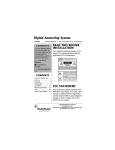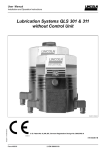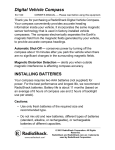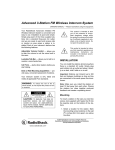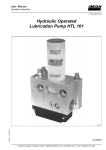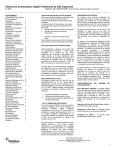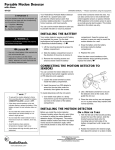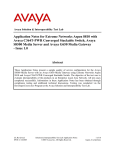Download Radio Shack ET 1754 Owner`s manual
Transcript
Please read before using this equipment. Owner’s Manual ET 1754 2-Line Trim Phone with 13-Number Memory ˆ Read This Before Installation FCC STATEMENT This phone is Hearing Aid compatible. Your phone complies with Part 68 of FCC Rules. You must, upon request, provide the FCC registration number and the REN to your telephone company. Both numbers are on the bottom of the phone. Note: You must not connect your phone to: • coin-operated systems • party-line systems • most electronic key telephone systems We have designed your phone to conform to federal regulations, and you can connect it to most telephone lines. However, each phone (and each device, such as an answering machine) that you connect to the telephone line draws power from the telephone line. We refer to this power draw as the device's ringer equivalence number, or REN on the bottom of your phone. If you use more than one phone or other device on the line, add up all of the RENs. If the total is more than five (three in rural areas), your telephones might not ring. If ringer operation is impaired, remove a device from the line. In the unlikely event that your phone causes problems on the phone line, the phone company can temporarily discontinue your service. If this happens, the phone company attempts to notify you in advance. If advance notice is not practical, the phone company notifies you as soon as possible and advises you of your right to file a complaint with the FCC. Also, the phone company can make changes to its lines, equipment, operations, or procedures that could affect the operation of this telephone. The telephone company notifies you of these changes in advance, so you can take the necessary steps to prevent interruption of your telephone service. THE FCC WANTS YOU TO KNOW This equipment has been tested and found to comply with the limits for a Class B digital device, pursuant to Part 15 of the FCC Rules. These limits are designed to provide reasonable protection against harmful interference in a residential installation. This equipment generates, uses and can radiate radio frequency energy and, if not installed and used in accordance with the instructions, may cause harmful interference to radio communications. However, there is no guarantee that interference will not occur in a particular installation. If this equipment does cause harmful interference to radio or television reception, which can be determined by turning the equipment off and on, the user is encouraged to try to correct the interference by one or more of the following measures: • Reorient or antenna. relocate receiving • Increase the separation between the equipment and receiver. • Connect the equipment into an outlet on a circuit different from that to which the receiver is connected. © 2002 RadioShack Corporation. All Rights Reserved. RadioShack and RadioShack.com are trademarks used by RadioShack Corporation. 2 the Read This Before Installation • Consult your local RadioShack store or an experienced radio/TV technician for help. • If you cannot eliminate the interference, the FCC requires that you stop using your phone. Changes or modifications not expressly approved by RadioShack may cause interference and void the user’s authority to operate the equipment. LIGHTNING Your telephone has built-in protection circuits to reduce the risk of damage from surges in telephone line and power line current. These protection circuits meet or exceed the FCC requirements. However, lightning striking the telephone or power lines can damage your telephone. Lightning damage is not common. Nevertheless, if you live in an area that has severe electrical storms, we suggest that you unplug your phone when storms approach to reduce the possibility of damage. Read This Before Installation 3 ˆ Contents Installation .............................................................................................................................. Selecting A Location ............................................................................................................ Mounting the Phone ............................................................................................................. On a Desktop ................................................................................................................... On a Wall Plate ................................................................................................................ On a Wall ......................................................................................................................... Installing the Battery ............................................................................................................ Connecting the Handset ...................................................................................................... 5 5 5 5 5 5 6 6 Preparation ............................................................................................................................. Setting the Dialing Mode ...................................................................................................... Setting the Ringer ................................................................................................................ Turning Off the Line 2 Indicator ............................................................................................ Checking the Line Status Indicators .................................................................................... 7 7 7 7 7 Operation ................................................................................................................................ Using the Data Port .............................................................................................................. Switching Between Lines ..................................................................................................... Making a Call on Another Line ........................................................................................ Answering a Call on Another Line ................................................................................... Making a Conference Call .................................................................................................... 8 9 9 9 9 9 Memory Operation ................................................................................................................ Storing a Number in Memory ............................................................................................. Dialing a Stored Number .................................................................................................... Testing Stored Emergency Numbers ................................................................................. Chain-Dialing Special Service Numbers ............................................................................ 10 10 10 10 10 Troubleshooting ................................................................................................................... 11 Care ................................................................................................................................... 11 4 Contents ˆ Installation SELECTING A LOCATION 3. Plug the other end of the cord into a modular phone jack. You can place the phone on a desk or table, on a standard wall plate or mount it directly on a wall. Select a location that is: On a Wall Plate 1. Plug one end of the supplied short modular cord into the modular jack on the back of the phone. • near a telephone line jack • out of the way of normal activities • away from electrical machinery, electrical appliances, metal walls, filing cabinets, wireless intercoms, security alarms, and room monitors Your telephone connects directly to a modular telephone line jack. If your telephone wiring does not have a modular jack, you can update the wiring yourself using jacks and adapters (available at your local RadioShack store), or have the telephone company update the wiring for you. You must use compatible modular jacks that are compliant with Part 68 of FCC Rules. The telephone cord and modular plug provided is Part 68 compliant for connecting to the telephone company network. Note: The USOC number of the single-line jack to be installed is RJ11C (or RJ11W for a wall plate jack). The USOC number for a two-line jack is RJ14C (or RJ14W for a wall plate). 2. Route the phone cord through the first tab, then into the groove leading to the rectangular space. Secure the cord with the tabs. 3. Plug the other end of the cord into a wall plate with a modular phone jack. Press any excess cord into the rectangular space on the bottom of the system to keep it out of the way. 4. Fit the wall plate studs into the keyhole slots on the bottom of the phone, then slide the base down to secure it. MOUNTING THE PHONE On a Wall On a Desktop 1. Plug one end of the supplied long modular cord into the modular jack on the base’s bottom. 2. Route the phone cord through the groove on the base’s bottom. Secure the cord under the tabs along the groove. 1. Drill two holes 31/4 inches (82.5 mm) apart, one below the other. Thread two screws (not supplied) into each hole, letting the heads extend about Installation 1/4 in 31/4 in 1/4 in 5 1/4-inch (6.3 mm) from the wall. (Be sure to use screws with heads that fit into the keyhole slots on the base’s bottom). 2. Plug one end of the supplied long modular cord into the modular jack on the base’s bottom. 3. Route the phone cord through the groove on the base’s bottom, securing the cord under the tabs. 4. Fit the heads of the screw into the bottom’s keyhole slots, then slide the base down until it is secure. 5. Plug the other end of the cord into a modular phone jack. INSTALLING THE BATTERY Your phone requires four AA batteries (not supplied) to power the LINE indicators. For the best performance and longest life, we recommend RadioShack alkaline batteries. Cautions: • Use only fresh batteries of the required size and recommended type. • Do not mix old and new batteries, or different types of batteries. Follow these steps to install batteries. line’s battery status when the phone is offhook. If Line 1 is in use, BATT LOW lights when no battery is installed for Line 1 or when Line 1’s batteries are low. When this happens, replace the batteries. Note: The BATT LOW indicator remains off when batteries are sufficient. Warning: Dispose of old batteries promptly and properly. Do not burn or bury them. Caution: If you do not plan to use the phone for a month or more, remove the batteries. Batteries can leak chemicals that can destroy electronic parts. CONNECTING THE HANDSET To connect the handset to the phone’s base, plug one end of the supplied coiled cord into the modular jack on the handset. Plug the other end into the jack on the side of the base. Place the handset in the cradle. Your local RadioShack store sells a variety of longer coiled handset cords, which are useful when you mount the system on a wall. 1. Use a flat-blade screwdriver to lift up the battery compartment cover, then remove the cover. 2. Place the batteries in the compartment as indicated by the polarity symbols (+ and –) marked inside. Be sure each line compartment has two batteries. 3. Replace and snap the cover into place. Each LINE indicator requires two batteries for power. The BATT LOW indicator shows a 6 Installation ˆ Preparation SETTING THE DIALING MODE CHECKING THE LINE STATUS INDICATORS Set PULSE/TONE on the handset for the type of service you have. If you are not sure which type you have, follow these steps to perform a test. You can check the status of each line by glancing at the line status indicator. 1. Lift the handset and set PULSE/TONE to TONE. When you hear the dial tone, press any number other than 0. Note: If your phone system requires that you dial an access code (9, for example) before you dial an outside number, do not press the access code either. # does not function when PULSE/TONE is set to PULSE. Indicator Line is Flashes slowly Phone is on hold (on a parallel phone or line). Light on Phone or parallel phone is in use. Flashes rapidly Phone is ringing (continues flashing until ringing stops or the phone line is picked up). Not lit Phone is not in use. 2. If the dial tone stops, you have touchtone service. Leave PULSE/TONE set to TONE. If the dial tone continues, you have pulse service. Set PULSE/TONE to PULSE. SETTING THE RINGER To adjust the ringer volume, set each line’s RINGER to HI, LO or OFF. With the ringer off, you can still answer calls if you hear an extension phone ring or see one of the phone’s LINE indicators flash. TURNING OFF THE LINE 2 INDICATOR If you want to install the phone as a one-line phone, you can turn off the LINE 2 indicator by removing the batteries for Line 2. Preparation 7 ˆ Operation VOLUME — Set to LO to hear a medium volume through the handset or to HI for a louder handset volume. FLASH — Use to perform the switchhook operation for special services, such as Call Waiting. For example, if you have Call Waiting, press FLASH to take an incoming call without disconnecting the current call. Press FLASH again to return to the first call. Notes: If you do not have special phone services, pressing FLASH might disconnect the current call. When CONF is pressed, FLASH has no function REDIAL — To dial the last number dialed, lift the handset. When you hear the dial tone, press REDIAL. The phone dials the last number dialed. RESET — At the end of a call, you can make your next call without placing the handset in the cradle. Press RESET to hang up the current call, then dial the next number. Note: When CONF is pressed, RESET has no function LINE 1 and LINE 2 — Press the line button to select a line, then lift the handset and dial the number. When you receive a call, that line’s indicator flashes rapidly until the line stops ringing. To answer the call, press the corresponding line button (LINE 1 or LINE 2), then lift the handset. To end a call, hang up the handset. HOLD — Press to place a call on hold. The line indicator flashes slowly. To return to the call, press its line button or pick up a parallel phone. Note: Pressing another line button without pressing HOLD disconnects the current call. 8 Operation USING THE DATA PORT The phone is equipped with an extra phone jack that allows you to connect a communication device (a computer modem, answering machine, or fax machine) to Line 2. Connect a line cord (not supplied) from the communication device to DATA on the back of the phone. Note: You cannot use Line 2 while a computer modem or fax machine is connected to DATA and in use. Line 1 still functions normally. When you are finished using the modem or fax machine, Line 2 becomes available again. MAKING A CONFERENCE CALL 1. Make or answer a call. 2. Press HOLD, then make or answer a call on another line. 3. When the second call is connected, press CONF. The lines are immediately connected. 4. To end the conference call, hang up. Both parties are disconnected, or you can press a LINE if you wish to continue with the call on that line. The party on the other line is disconnected. The USOC number of the data jack to be installed is RJ11. SWITCHING BETWEEN LINES Making a Call on Another Line 1. Press HOLD to place the first call on hold. 2. Press the LINE not in use, then dial the desired number. 3. Press the first call’s LINE at any time to return to the first call. Answering a Call on Another Line 1. Press HOLD to place the first call on hold. 2. Press the flashing LINE to answer the incoming call. 3. To switch back to the first call, press HOLD to place your current call on hold. 4. Press the other LINE to return to the first call. Operation 9 ˆ Memory Operation The phone has two types of memory — priority and standard — that let you store and dial up to 13 phone numbers. You can store up to 3 phone numbers (up to 16 digits each) in priority memory and dial them by pressing a single button. You can store up to 10 phone numbers (up to 16 digits each) in standard memory and dial those numbers by pressing two buttons. STORING A NUMBER IN MEMORY With the phone off the hook, press STORE. Enter the phone number you want to store. To store the number in one of the priority memory locations, press STORE again, then press M1, M2, or M3, then hang up the phone. To store the number in one of the standard memory locations, press STORE again, then press one of the memory locations (0–9). Hang up the phone. Notes: • For security purposes, we recommend that you do not store private numbers, such as personal identification numbers or passwords. • You cannot erase a number in memory, but you can replace it by storing a new one in its place. DIALING A STORED NUMBER To dial a phone number stored in a priority memory location, simply press that number’s priority memory (M1, M2, or M3). To dial a phone number stored in a standard memory location, press MEMORY then the desired memory number (0–9). TESTING STORED EMERGENCY NUMBERS If you store the number of an emergency service (police department, fire department, ambulance) and you choose to test the stored number, remain on the line to explain the reason for your call. Make the test call during the late evening or early morning hours to avoid periods of peak demand. CHAIN-DIALING SPECIAL SERVICE NUMBERS For quick recall of numbers for special services (such as alternate long-distance or bank-by-phone), you can store each group of numbers in its own memory location. When calling special services, dial the service’s main number first. At the appropriate place in the call, press the appropriate memory number for the additional numbers you want to send. • Write the memory location number and the name associated with that number on the system’s memory dialing card. Remove the card’s cover by lifting its edge. 10 Memory Operation ˆ Troubleshooting We do not expect you have any problems with your Two Line Phone, but if you do, try these suggestions. Problem Suggestions No dial tone Be sure you pressed down the correct LINE. Check that the phone line and handset cords are securely connected. Line 1 works, but Line 2 does not Be sure you pressed down the correct LINE. Check that the line cord is correctly connected to an RJ14C jack. (RJ14C jacks normally have four visible wire contacts.) Check that the batteries are installed. If the batteries are not installed for Line 2, its indicator will not work. Low volume or unusual sounds Someone has picked up another phone on the same line. Hang up the other phone. If you still have problems, disconnect the phone. If other phones on the same line work properly, the fault is in this phone or its installation. If you cannot find the problem, take the phone to your local RadioShack store for assistance. CARE Keep the phone dry; if it gets wet, wipe it dry immediately. Use and store the phone only in normal temperature environments. Handle the phone carefully; do not drop it. Keep the phone away from dust and dirt, and wipe it with a damp cloth occasionally to keep it looking new. Modifying or tampering with the phone’s internal components can cause a malfunction and might invalidate its warranty and void your FCC authorization to operate it. If your phone is not performing as it should, take it to your local RadioShack store for assistance. If the trouble is affecting the telephone lines, the phone company can ask you to disconnect your phone until you have resolved the problem. Troubleshooting 11 Limited One-Year Warranty This product is warranted by RadioShack against manufacturing defects in material and workmanship under normal use for one (1) year from the date of purchase from RadioShack company-owned stores and authorized RadioShack franchisees and dealers. EXCEPT AS PROVIDED HEREIN, RadioShack MAKES NO EXPRESS WARRANTIES AND ANY IMPLIED WARRANTIES, INCLUDING THOSE OF MERCHANTABILITY AND FITNESS FOR A PARTICULAR PURPOSE, ARE LIMITED IN DURATION TO THE DURATION OF THE WRITTEN LIMITED WARRANTIES CONTAINED HEREIN. EXCEPT AS PROVIDED HEREIN, RadioShack SHALL HAVE NO LIABILITY OR RESPONSIBILITY TO CUSTOMER OR ANY OTHER PERSON OR ENTITY WITH RESPECT TO ANY LIABILITY, LOSS OR DAMAGE CAUSED DIRECTLY OR INDIRECTLY BY USE OR PERFORMANCE OF THE PRODUCT OR ARISING OUT OF ANY BREACH OF THIS WARRANTY, INCLUDING, BUT NOT LIMITED TO, ANY DAMAGES RESULTING FROM INCONVENIENCE, LOSS OF TIME, DATA, PROPERTY, REVENUE, OR PROFIT OR ANY INDIRECT, SPECIAL, INCIDENTAL, OR CONSEQUENTIAL DAMAGES, EVEN IF RadioShack HAS BEEN ADVISED OF THE POSSIBILITY OF SUCH DAMAGES. Some states do not allow limitations on how long an implied warranty lasts or the exclusion or limitation of incidental or consequential damages, so the above limitations or exclusions may not apply to you. In the event of a product defect during the warranty period, take the product and the RadioShack sales receipt as proof of purchase date to any RadioShack store. RadioShack will, at its option, unless otherwise provided by law: (a) correct the defect by product repair without charge for parts and labor; (b) replace the product with one of the same or similar design; or (c) refund the purchase price. All replaced parts and products, and products on which a refund is made, become the property of RadioShack. New or reconditioned parts and products may be used in the performance of warranty service. Repaired or replaced parts and products are warranted for the remainder of the original warranty period. You will be charged for repair or replacement of the product made after the expiration of the warranty period. This warranty does not cover: (a) damage or failure caused by or attributable to acts of God, abuse, accident, misuse, improper or abnormal usage, failure to follow instructions, improper installation or maintenance, alteration, lightning or other incidence of excess voltage or current; (b) any repairs other than those provided by a RadioShack Authorized Service Facility; (c) consumables such as fuses or batteries; (d) cosmetic damage; (e) transportation, shipping or insurance costs; or (f) costs of product removal, installation, set-up service adjustment or reinstallation. This warranty gives you specific legal rights, and you may also have other rights which vary from state to state. RadioShack Customer Relations, 200 Taylor Street, 6th Floor, Fort Worth, TX 76102 We Service What We Sell RadioShack Corporation Fort Worth, Texas 76102 12/99 43-1754 LIB881YY 01A02 Printed in China












